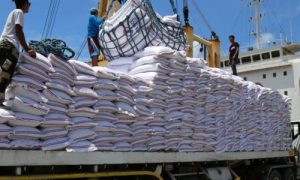Kenya among countries facing grain shortage

Kenya, along with several Eastern and Southern African countries, faces a significant grain shortage due to climate change impacts, prompting increased imports of maize and other staples. Despite a reduction in inflation to 4.3% in July, the country will still rely on imports from Uganda, Tanzania, and Ethiopia to address the deficit. The region has signed grain trade contracts worth $409 million, aiming to balance supply and demand amid low local production and high food costs.
Kenya is among countries in the Eastern and Southern regions facing a grain shortage, which will force it to import from neighbouring states and other international markets to bridge the deficit, experts now say.
It is estimated that close to 70 per cent of the countries will continue to import food to meet their deficit following increased effects of climate change.
Alongside South Sudan, Somalia, Rwanda, and Burundi, the country is expected to import mainly maize, although at a lower level, from Uganda, Tanzania and Ethiopia to meet their deficit.
The competition for the tradable surplus within the region will likely direct more flows to Kenya and the eastern parts of the Democratic Republic of Congo, where the purchasing power and prices are relatively higher.
The countries are feared to continue to grapple with high cost of living and increased import bill as the nation’s endeavour to feed their population.
This is despite inflation numbers in countries such as Kenya indicating a significant drop, recorded at 4.3 per cent in July, edging down from June’s 4.6 per cent, pegged on lower food prices.
Industry data shows the per capita consumption of maize in Kenya averages 98–103 kilogrammes, compared to 73, 52 and 31 kgs in Tanzania, Ethiopia and Uganda, respectively.
Maize production in Kenya increased by 38.8 percent from 34.3 million bags in 2022 to 47.6 million bags in 2023 on improved weather conditions and state interventions.
During an Eastern and Southern Africa public-private policy dialogue and grain trade business to business forum held in Dar es Salaam, Tanzania, it was however noted that more than 60 per cent of the region’s countries are facing low maize production levels, following interruption of the crop by effects of climate change.
Despite the low supply of food, Eastern and Southern Africa governments commit to facilitate the private sector to undertake trade following signing of grain trade contracts valued at $409 million (Sh53.1 billion).
The forum organised by TradeMark Africa (TMA) in collaboration with the Eastern Africa Grain Council (EAGC) and the Alliance for a Green Revolution in Africa (AGRA), noted that the region will have to rely on markets enjoying surplus to feed their population.
Kenya has traditionally imported grain, mainly maize and wheat, to bridge the deficit in the country.
Kenya’s major wheat supplier is Russia followed by Argentina, Germany , Poland, Canada, Latvia and Ukraine.
The regional grain trade B2B forum resulted in signing of trade contracts amounting to 748,854 metric tonnes of assorted grains and pulses, valued at $409 million, expected to be traded across the region.
“This demonstrates the enormous potential and demand for staple foods from surplus to deficit regions, emphasising the importance of seamless trade,” EAGC executive director Gerlad Masila noted.
Traders have started executing the new trade deals, with EAGC connecting them to the regional commercial banks to secure credit to finance the grain business in the region.
“We hope the new deals will strengthen trade in the region,” said Masila.
According to the Eastern Africa Grain Council, only, Ethiopia, Tanzania and Uganda are enjoying maize surplus and thus act as the saving granary which the rest of the two regions will have to import to meet their deficit.
“Proximity to major producing areas will incentivize flows from Western and Southwestern Uganda to Rwanda, Northern Uganda to South Sudan and eastern Tanzania to Burundi,”Masila noted.
The forum attracted 120 delegates, including producers, traders, millers, and exporters from Kenya, Uganda, Tanzania, Rwanda, Burundi, DRC, Malawi, Zambia, and Ethiopia.
During the 2024-25 production year, 438 770 metric tonnes of maize valued at $153.5 million (Sh19.9 billion) is expected to be traded within the region.
Maize prices are expected to follow seasonal trends across all countries but generally remain lower than last year, due to increased domestic supply, except in Ethiopia, South Sudan, and Somalia.
This has been pegged on localised areas of below-average production, conflict-related disruptions in supply, and persistent inflation.
The prices are expected to remain higher than average in most countries because of high production, fuel, and transport costs.
“The prices are expected to be lower than average in Uganda and Tanzania because of increased domestic supply and lower shortfalls in deficit countries,” EAGC noted in its outlook.
For example, Uganda is exacted to experience above-average harvests and increased supply, a scenario likely to keep sorghum prices at just below-average levels and thus attracting demand from Kenya and South Sudan.
Nega Wubeneh, head of markets and trade at AGRA, noted that the African continent is currently grappling with a $41 billion (Sh5.3 trillion) food import bill and the same is expected to increase over $100 billion (Sh12.9 trillion) by 2025.
In the last cropping season, the Southern Africa countries including Malawi, Zambia, Mozambique experienced a devastating dry spell associated with El nino induced drought, that have adversely affected crop production.
“Projections indicate that all countries in Southern Africa have below average staple production and supplies from the 2024 cereal harvest and are expected to be insufficient to cover regional requirements from marketing year 2024-25,”Wubeneh said.
While most deficit countries have removed import duties for maize and other grains, sanitary and phytosanitary regulations will likely act as a non-tariff barrier to regional trade.
Source Link : https://www.the-star.co.ke/business/kenya/2024-08-04-kenya-among-countries-facing-grain-shortage/

















